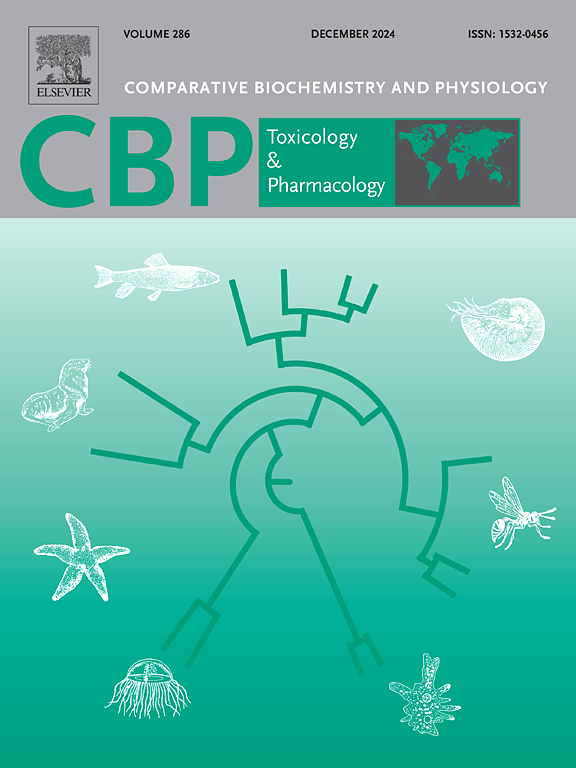Protective effect of Qiukui Taoren Recipe against acute renal injury by inhibiting oxidative stress, inflammation and apoptotic pathways
IF 4.3
3区 环境科学与生态学
Q2 BIOCHEMISTRY & MOLECULAR BIOLOGY
Comparative Biochemistry and Physiology C-toxicology & Pharmacology
Pub Date : 2025-06-16
DOI:10.1016/j.cbpc.2025.110253
引用次数: 0
Abstract
Okra and peach kernel, named Qiukui and Taoren in China, respectively, which can be used for medicine and food, are widely applied for the treatment of multifaceted diseases. However, the protective effects against acute kidney injury (AKI) and the underlying mechanisms have not been fully assessed. The aim of this study was to assess the protective effect of Qiukui Taoren Recipe (QT), and the potential molecular mechanisms in AKI using network pharmacology prediction, in vivo and in vitro experiment. There were 42 active components of QT detected by HPLC-Q-TOF/MS, and network pharmacology showed that these active components mainly could act with 63 core targets such as TNF-α, Caspase-3, BCL2, STAT3, PPARγ, and regulated 110 signaling pathways for alleviating AKI. In addition, QT reduced periocular oedema, renal malformations and size reduction, partially restore renal excretory function, and reduced the accumulation of proteinuria in zebrafish AKI model induced by caristolochic acid (AA). QT could upregulate the mRNA expression of Nephrin and oxidative stress genes (Nrf2, HO-1, PPARγ), and downregulate inflammation- and apoptosis-related genes (IL-1β, IL-6, TNF-α, NF-κB, Caspase-3, P53). Furthermore, QT inhibited ROS elevation and apoptosis activated by cisplatin (CDDP) in HEK293T cells. Western blotting results showed that QT could enhance the protein expression of nephrin, and inhibited the protein expression of Kim-1, IL-18, NLRP3, STAT3, P53 and Caspase-3. Overall, these results indicated the protective effect of QT against AKI was due to the inhibition of oxidative stress, inflammation-and apoptosis-related pathways.

秋葵桃仁方通过抑制氧化应激、炎症和凋亡通路对急性肾损伤的保护作用
秋葵和桃仁在中国分别被称为秋葵和桃仁,可以用作药物和食物,被广泛应用于治疗多方面疾病。然而,对急性肾损伤(AKI)的保护作用及其潜在机制尚未得到充分评估。本研究旨在通过网络药理学预测和体内、体外实验,探讨秋葵桃仁方(QT)对AKI的保护作用及其可能的分子机制。HPLC-Q-TOF/MS检测到42种QT活性成分,网络药理学结果显示,这些活性成分主要作用于TNF-α、Caspase-3、BCL2、STAT3、PPARγ等63个核心靶点,调节110条信号通路,缓解AKI。此外,在斑马鱼肝石酸(AA)诱导的AKI模型中,QT可减轻眼周水肿、肾脏畸形和大小缩小,部分恢复肾脏排泄功能,减少蛋白尿积聚。QT可上调Nephrin和氧化应激基因Nrf2、HO-1、PPARγ的mRNA表达,下调炎症和凋亡相关基因IL-1β、IL-6、TNF-α、NF-κ b、Caspase-3、P53的mRNA表达。此外,QT可抑制HEK293T细胞ROS升高和顺铂(CDDP)激活的细胞凋亡。Western blotting结果显示QT可增强nephrin蛋白表达,抑制Kim-1、IL-18、NLRP3、STAT3、P53、Caspase-3蛋白表达。总的来说,这些结果表明QT对AKI的保护作用是由于抑制氧化应激、炎症和细胞凋亡相关途径。
本文章由计算机程序翻译,如有差异,请以英文原文为准。
求助全文
约1分钟内获得全文
求助全文
来源期刊
CiteScore
7.50
自引率
5.10%
发文量
206
审稿时长
30 days
期刊介绍:
Part C: Toxicology and Pharmacology. This journal is concerned with chemical and drug action at different levels of organization, biotransformation of xenobiotics, mechanisms of toxicity, including reactive oxygen species and carcinogenesis, endocrine disruptors, natural products chemistry, and signal transduction with a molecular approach to these fields.

 求助内容:
求助内容: 应助结果提醒方式:
应助结果提醒方式:


